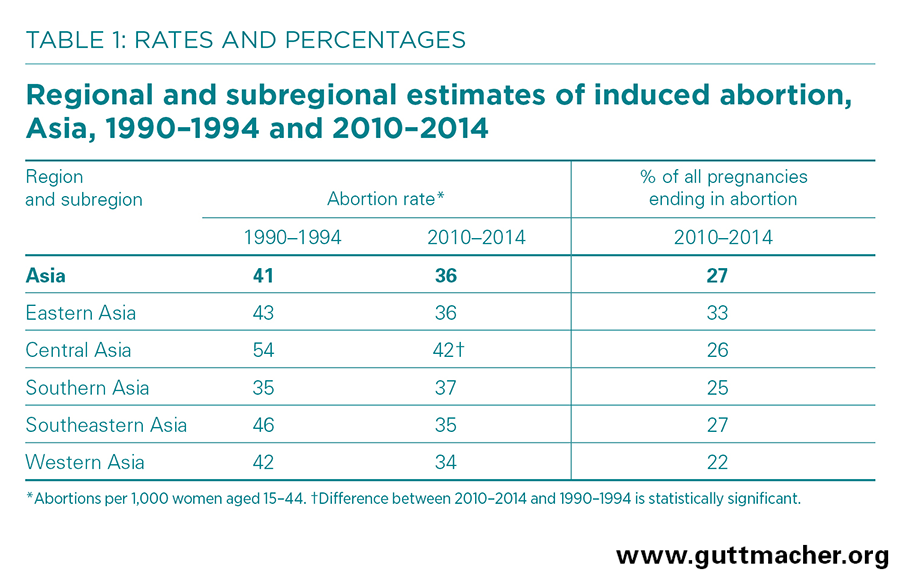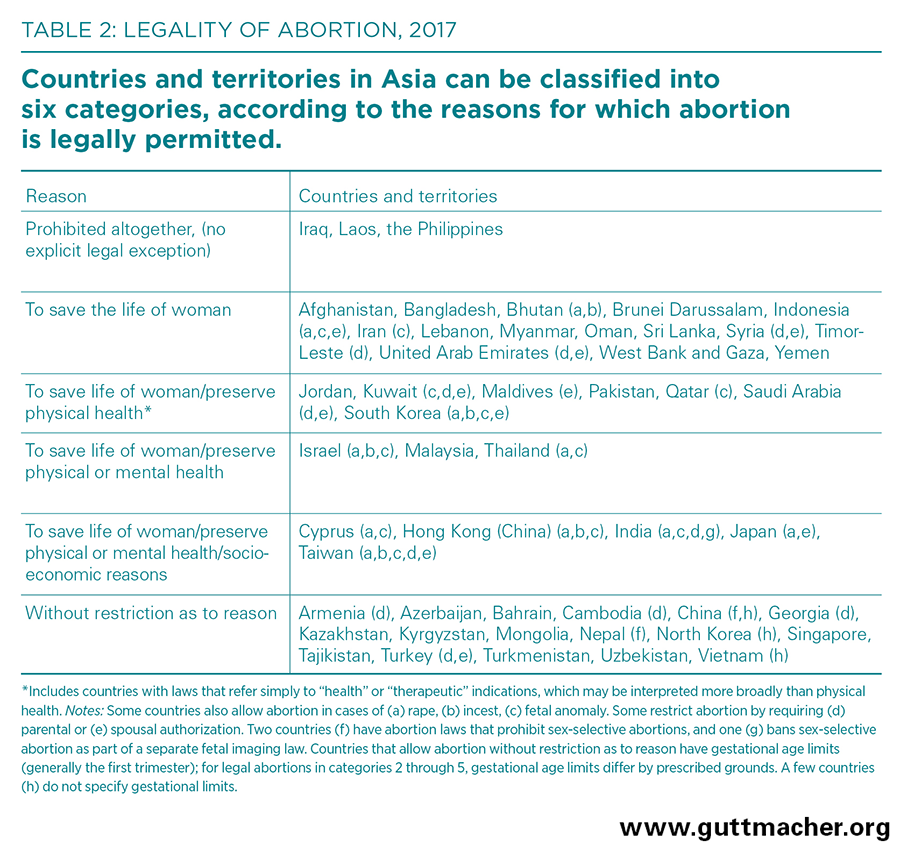Incidence and trends
- During 2010–2014, an estimated 35.5 million induced abortions occurred each year in Asia.
- The annual rate of abortion for the region is an estimated 36 per 1,000 women of reproductive age (15–44), which is down slightly from 41 per 1,000 in 1990–1994.
- The regional abortion rate is roughly 36 per 1,000 for married women and 24 per 1,000 for unmarried women.1
- Abortion rates in four of Asia’s five subregions (Eastern, Southern, Southeastern and Western) are close to the overall regional rate; the rate in Central Asia is higher (42 per 1,000 women).
- The proportion of all pregnancies in Asia ending in abortion each year, estimated at 27% in 2010–2014, has remained roughly the same since 1990–1994; by subregion, the proportion ranges from 22% in Western Asia to 33% in Eastern Asia.1
Legal status of abortion
- Because abortion is broadly legal in the region’s two most populous countries, China and India, the majority of women in Asia live under liberal abortion laws.
- Abortion is not permitted for any reason in three Asian countries: Iraq, Laos and the Philippines.
- Seventeen out of 50 countries and territories in Asia allow abortion without restriction as to reason.
- Even where abortion is broadly legal, many women continue to face barriers to obtaining safe, legal procedures. Obstacles include difficulty finding providers willing to perform abortion, substandard conditions in health facilities, lack of awareness of the legal status of abortion and fear of stigmatization for terminating a pregnancy.2
Unsafe abortion and its consequences
- Induced abortion is medically safe when WHO-recommended methods are used by trained persons, less safe when only one of those two criteria is met, and least safe when neither is met.
- As of 2010–2014, the majority (89%) of abortions in Eastern Asia—which includes China—are safe. In Southern and Central Asia together, less than half of abortions are safe.3
- In 2012, approximately eight per 1,000 women of reproductive age in Asia (excluding Eastern Asia) were treated for complications from unsafe abortion. In all, about 4.6 million women in the region are treated for such complications each year.4
- In 2014, at least 6% of all maternal deaths (or 5,400 deaths) in Asia were from unsafe abortion.5
- The most common complications from unsafe abortion are incomplete abortion, excessive blood loss and infection.
- Some women with untreated complications experience long-term health consequences, such as chronic pain, inflammation of the reproductive tract, pelvic inflammatory disease and infertility.
- Poor and rural women are the most likely to experience an unsafe abortion and severe complications thereof.
- Unsafe abortion has negative consequences beyond its immediate effects on individual women’s health. Treating complications from unsafe abortion increases the economic burden on poor families and incurs considerable costs to already struggling public health systems.
- The extent to which medication abortion is used to induce abortions in Asia is not known; however, evidence indicates that sales of these drugs have increased in the region in the past decade.6
Unintended pregnancy and unmet need
- As of 2017, almost 132 million women of reproductive age in Asia have an unmet need for modern contraception—that is, they want to avoid a pregnancy but are either not practicing contraception or are using traditional methods, which are less effective than modern methods.7
- Most women who have an abortion do so because they become pregnant when they do not intend to. As of 2010–2014, the rate of unintended pregnancies in Asia is 54 per 1,000 women aged 15–44.
- An estimated 53.8 million unintended pregnancies occur each year in Asia. Of these, nearly two-thirds (65%) end in abortion.
Recommendations
- Programs and policies that improve women’s and men’s knowledge of, access to and use of contraceptive methods must be implemented to reduce unintended pregnancies—and the abortions or unplanned births that often follow.
- The provision and quality of postabortion care should be improved and expanded to reduce illness and death from unsafe abortion.
- The grounds for legal abortion should be broadened and access to safe abortion services improved to reduce the number of clandestine procedures and the negative consequences that often result.
- Liberal abortion laws alone do not ensure procedures will be safe. Service provision guidelines must be adopted and disseminated, providers must be trained, and governments must be committed to ensuring that safe abortions are available.

